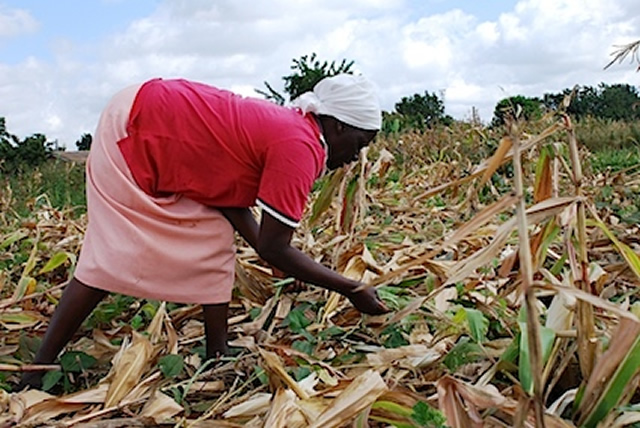Urban agric – authorities found wanting

 Elliot Siamonga
Elliot Siamonga
THE impending crackdown on stream bank cultivators by the Bulawayo City Council exposes the glaring failure by city planners to properly designate plots for urban agriculture as well as failure to implement relevant by laws that prohibit such cultivation.Last year the same local authority bowed down to pressure from city residents and some politicians to stop slashing crops; however failure to carefully manage and implement the Urban Agriculture policy has dogged the authority.
The scenario is likely to cause a showdown that could have been easily avoided had the authority been proactive in dealing with these urban agriculturists.
The plots have sustained most elderly families in the city who cannot afford to buy food and have been sidelined by the same authority’s pro-poor programmes.
With the onset of the rainy season families who depend on farming in these undesignated places have already started clearing their rugged pieces of land oblivious to warnings of fined or have their crops slashed.
The Environmental Management Authority fines local authorities $5,000 for every case of stream bank cultivation as they consider it as failure to enforce by-laws prohibiting residents to cultivate in undesignated areas.
Stream bank cultivation contravenes statutory instrument 7 of 2007 that any operation including cultivation, should be at least 30 metres from the highest flood level of any river, stream or natural water-ways. Cultivation is also prohibited on wetlands, hilltops or steep slopes.
In an ever more interdependent world, the global challenges of climate change, food and financial crises are putting pressure on food systems.
It is therefore ever more important to re-examine the resilience of small-holder agriculture and its great contribution both to local and global food security.
Given the dire food situation globally, there is need for proper educational awareness campaigns from all stakeholders that include the Environmental Management Agency, City of Bulawayo, urban agriculture associations and residents.
Agriculturalists have estimated that half of the world’s population will live in urban areas and cities by 2015, and this calls for improved crop and livestock production for food security in these cities.
Urban agriculture in Zimbabwe in the past was a rare activity among residents but the situation has since changed as the life of hundreds of people is being sustained through urban agriculture.
This type of farming also took shape soon after independence when the Zimbabwean government relaxed some of the repressive urban council by-laws the prohibited farming on the periphery of the cities. Since then, according to the Urban Agriculture Forum of Zimbabwe, this type of farming has contributed immensely to food security amongst some poor urban households.
Although some of the laws that prohibit farming near rivers and streams are still being enforced, food shortages that were experienced in the country due to economic factors and droughts resulted in the flouting of these laws often leading to clashes between urban farmers and municipal authorities.
In the past, urban agriculture was not a priority in the citites. The towns were reserved for people who came to work. However, over the years that notion has been overtaken by events.
Urban agriculture defined as a system of land use for agricultural purposes for crop production and animal husbandry within the urban environment has become so popular and has virtually transformed land on the outskirts of most suburbs into green belts, despite concerns from environmentalists who cited serious deforestation as people clear the land for farming activities.
Bulawayo was at the forefront in formulating a policy in 1995 that encouraged urban agriculture among its dwellers.
The main objective of the policy was to enable the low-income earners to supplement their incomes as well as ensure effective utilisation of undeveloped land.
Urban agriculture was developed out of the practical need to supplement the meagre weekly and monthly earnings of most residents.
However officials with some of these local authorities find themselves going against this general policy by ordering the destruction of crops in particular areas set aside for certain activities.
At one multi stakeholders meeting held at the Zimbabwe Farmers Union offices in Bulawayo in 2010 the then mayor of Bulawayo Councillor Thaba Moyo said residents should desist from farming practices that promote land degradation.
“We do not condemn urban agriculture, in fact we are supportive of the programme, but when you go against the law we are forced to act, land is a natural resource that should be preserved,” he said then.
According to the Bulawayo Protection of Lands and Natural Resources by-law section 13 (1) no person shall cultivate within 30 metres of the verge of any spring, vleis, sponges, marsh, swamp or reed bed.
The by-law also prohibits people from cultivating within 10 metres along road verges and former refuse dumps.
Legal experts however said the Urban Councils Act should specifically provide for urban farming.
When these laws were enacted urban agriculture had not grown into a major activity as is the case now, however regulations can be made in terms of these laws to permit farming in urban areas.
Section 227, clause 81(1) of the third schedule of the Urban Councils Act gives local authorities powers to make by-laws on a number of issues including prohibition or regulation of land cultivation and keeping of animals.
Other laws that impact on urban farming include the Regional Town and Country Planning Act (chapter 29.12).
Future land use planning policies should accept urban agriculture as a necessary and valuable part of city life.
Urban Agriculture is here to stay and improve the livelihoods of the urban population.
According to the Municipal Development Partnership for East and Southern Africa, (MDP-ESA) a non-governmental organisation that has also been working with city councils on projects meant to promote urban agriculture, noted in a research that:
“The vision for urban agriculture has been realised in many cities in the country and has prompted the establishment of an interdepartmental committees in most cities to examine the possibility of engaging in urban agriculture”.
To this end the Bulawayo City Council established a plantation just outside Luveve where scores of residents most unemployed are taking urban farming more seriously with the help of non-governmental organisations such as World Vision Zimbabwe.
During 2003, different ministers responsible for local government in eastern and southern Africa signed the Harare declaration on Urban and Peri-urban agriculture which acknowledged that although the urban farming was practised informally, without an appropriate policy, it played a significant role in promoting food security in urban communities.
The country can still do its bit in contributing to achieving the Millenium Development Goal to halve the prevalence of undernourishment in the developing world by 2015 if efforts are boosted to reverse the slowdown in progress.
The goal is one of the series of targets adopted by the world leaders at the United Nations in 2000 to slash poverty hunger and disease by 2015.
According to the Food and Agricultural Organisation (FAO), the World Food programme (WFP) agricultural growth involving small holders, especially women, will be most effective in reducing extreme poverty and hunger for the poor.










Comments